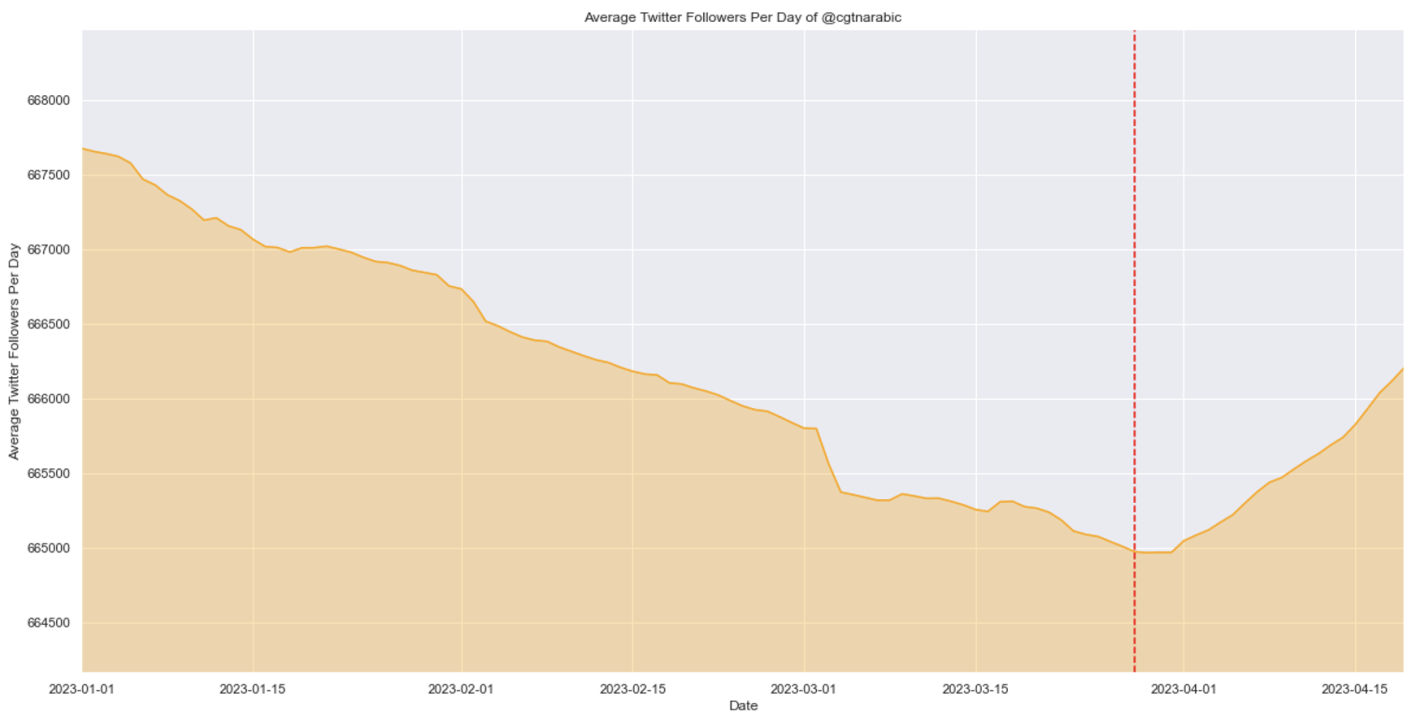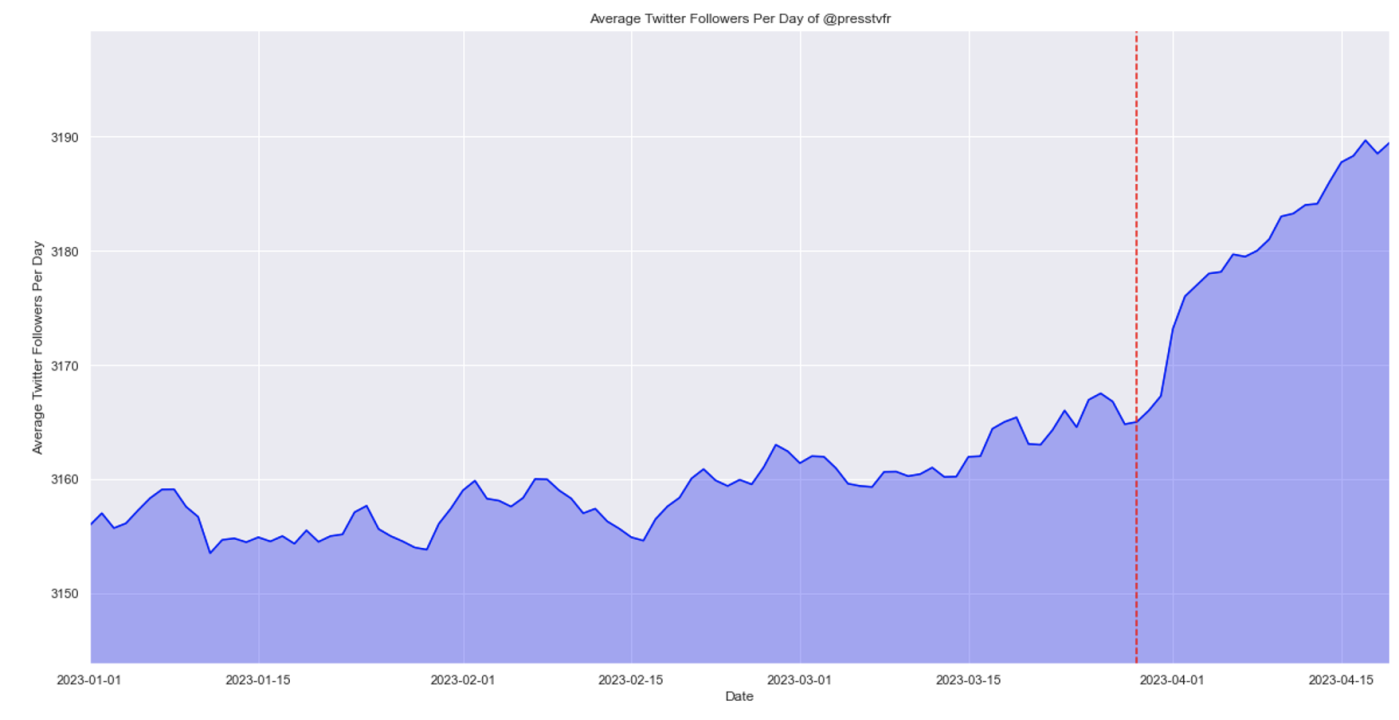State-controlled media experience sudden Twitter gains after unannounced platform policy change
Twitter accounts run by Russia’s RT, China’s CGTN and Iran’s PressTV suddenly began to gain followers; Twitter acknowledged a change in policy regarding state media accounts three weeks later
State-controlled media experience sudden Twitter gains after unannounced platform policy change
Share this story

BANNER: Twitter CEO Elon Musk. (Source: Reuters/Dado Ruvic/Illustration/File Photo)
Multiple Russian, Chinese, and Iranian state media outlets on Twitter simultaneously began to gain followers after months of decline or stagnation, the DFRLab has discovered. A DFRLab assessment suggests that Twitter changed its algorithms regarding these accounts around March 29, 2023. NPR confirmed on April 21 that Twitter had made the deliberate decision to stop filtering government accounts in Russia, China, and Iran. That same day, Reuters reported that Twitter had removed its state media labels from their accounts as well.
From August 7, 2020 until 21:10 GMT on April 6, 2023, Twitter’s Platform Use Guidelines on state-affiliated accounts stated, “In the case of state-affiliated media entities, Twitter will not recommend or amplify accounts or their Tweets with these labels to people.” By 23:39 GMT that evening, however, Twitter had removed this sentence from its platform policy. The change occurred after Semafor and VOA journalist Wenhao Ma wrote about how Twitter was no longer limiting state-affiliated media outlets on its platform.
Twitter’s policy change is significant, as Twitter can now algorithmically promote state-affiliated media outlets. Twitter users no longer must actively seek out state-sponsored content in order to see it on the platform; it can just be served to them. Many state-affiliated media outlets, particularly in authoritarian countries, publish content to exert influence, sometimes leveraging disinformation and propaganda in their articles to achieve these aims.
Meanwhile, many trusted news outlets in the US that receive limited government support, including NPR and PBS, have quit using the platform in recent days over disputes about Twitter labeling them as state-affiliated outlets. These labels were removed at the same time as their removal from Russian, Chinese and Iranian state media accounts. The exodus of reliable news outlets, combined with Twitter no longer moderating state-sponsored accounts which have built up significant presences, could lead to a very different information environment on Twitter. Russian, Chinese, and Iranian state media organizations have a significant presence on the platform; Russian television network Russia Today (RT) has at least nine accounts labeled by Twitter as “government-affiliated,” while the Chinese television network China Global Television Network (CGTN) has at least twenty-eight accounts labeled by Twitter, and Iran’s PressTV has at least five. Many of these accounts are targeted to specific regions and languages or topics.
While open-source researchers cannot access Twitter’s algorithms directly, analyzing Twitter data helps paint a picture of when this platform change likely occurred. DFRLab analysis indicates that this change actually occurred earlier than April 6 – likely around March 29, 2023. This suggests that for a period of time, Twitter may have violated their own Platform Use Guidelines, potentially serving state-sponsored content to Twitter users despite claiming that these accounts and their tweets were still being moderated.
Some Russian, Chinese, and Iranian state media accounts which Twitter had previously labeled as “government-affiliated” were hemorrhaging followers in the months prior to this policy update, then experienced rapid gains after Twitter instituted the change. While multiple factors could contribute to these accounts’ growth trajectory, the sudden, simultaneous increase in followers per day after a period of decline indicates platform-wide algorithmic change around March 29.
About our analysis
Using the social media monitoring platform Meltwater Explore, the DFRLab downloaded Twitter data from January 1, 2023 through April 19, 2023 for accounts labeled as “state-affiliated” and operated by Russia’s RT, China’s CGTN, and Iran’s PressTV. The DFRLab examined forty-two accounts from these three outlets, focusing on the subset of these accounts that tweeted over the same time period.
We sorted tweet-level data for each account to focus on their original tweets rather than retweets or quote tweets, resulting in a total of 146,666 tweets from these accounts in the time period. Given that many of these accounts tweeted multiple times per day, we measured average engagement on tweets per day to look for potential shifts in engagement. We calculated the average number of Twitter followers per day for those accounts that published original tweets during the same period; this was possible due to the fact that Meltwater Explore provides the number of account followers at the time of each original tweet.
Russian state media Twitter accounts: RT
RT has at least nine Twitter accounts that until April 20 were labeled as “government-affiliated” on the platform. The three most followed RT accounts – @rtarabic, @actualidadrt, and @rt_com – each have followings in the millions. Two showed dramatic increases in followers starting March 27 and March 28, 2023, while a third showed a slower increase in followers beginning April 5.
With over 5.2 million followers, @RTArabic is RT’s most followed account. From January 1 until March 28, @RTArabic’s average Twitter followers per day steadily decreased, when it then started trending upwards.

The same phenomenon can be observed in @RT_com, which has 3 million followers. The account’s average followers per day started to trend upwards on March 28. Average engagement on @RT_com’s original tweets started to climb earlier that month, though by how much remains unclear, as Meltwater Explore has blanks in its engagement data for 3 percent of @RT_com’s tweets.


@ActualidadRT, which has 3.4 million followers, similarly experienced a declining in followers in recent months, then started to increase in average followers April 5 and onwards. Average engagement on @ActualidadRT original tweets also appears to have increased, although Meltwater Explore has blanks in its engagement data for 10 percent of @ActualidadRT’s tweets.


Not all RT accounts appear to be receiving this algorithmic promotion, however. @RT_doc and @RTUKnews, which both have significantly fewer followers than the top RT accounts, continue to trend downward in follower accounts.
Chinese state media Twitter accounts: CGTN
CGTN operates at least twenty-eight Twitter accounts labeled as state-affiliated. Several of these accounts appear to be benefiting from Twitter’s new policy and have received sharp upticks of followers. Other accounts in this network appear to continue to be declining in followers.
@CGTNAmerica experienced an uptick in average followers per day beginning March 29, after a slow decline since at least January 1.

@Cgtnarabic and @cgtnafrica likewise started to climb in followers in late March after a general decline in the previous time period, on March 28 and April 1, respectively.


Other CGTN accounts did not experience a similar uptick, continuing their overall decline in followers over time despite tweeting this year; these include @cgtnenespanol, @cgtnfrancais, @cgtnofficial, @cgtnradio, @cgtnrussian, and @closertochina.
Iranian state media Twitter accounts: PressTV
Iran’s PressTV manages several state-labeled Twitter accounts, most of which have not been active this year in tweeting original content. Two of the accounts that have tweeted this year, @PressTV and @PressTVFR, experienced upticks in followers on March 29.

For @PressTVFr, the account already was already trending slightly upwards in average followers over time, then experienced increased growth on March 29. Its overall subscribership remains very low, however.

The DFRLab attempted to ascertain why certain state-affiliated accounts received upticks in followers beginning on March 29 and why others did not. It is possible there are certain follower threshold bands in which accounts are promoted or not promoted. A clear pattern is difficult to ascertain with certainty, however, as accounts with both large and small existing followers were promoted in late March and early April.
Cite this case study:
Alyssa Kann, “State-controlled media experience sudden Twitter gains after unannounced platform policy change,” Digital Forensic Research Lab (DFRLab), April 21, 2023, https://dfrlab.org/2023/04/21/state-controlled-media-experience-sudden-twitter-gains-after-unannounced-platform-policy-change.

